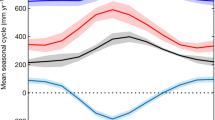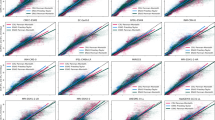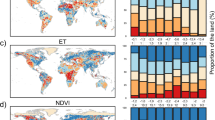Abstract
Global warming is expected to intensify the global hydrological cycle1, with an increase of both evapotranspiration (EVT) and precipitation. Yet, the magnitude and spatial distribution of this global and annual mean response remains highly uncertain2. Better constraining land EVT in twenty-first-century climate scenarios is critical for predicting changes in surface climate, including heatwaves3 and droughts4, evaluating impacts on ecosystems and water resources5, and designing adaptation policies. Continental scale EVT changes may already be underway6,7, but have never been attributed to anthropogenic emissions of greenhouse gases and sulphate aerosols. Here we provide global gridded estimates of annual EVT and demonstrate that the latitudinal and decadal differentiation of recent EVT variations cannot be understood without invoking the anthropogenic radiative forcings. In the mid-latitudes, the emerging picture of enhanced EVT confirms the end of the dimming decades8 and highlights the possible threat posed by increasing drought frequency to managing water resources and achieving food security in a changing climate.
This is a preview of subscription content, access via your institution
Access options
Subscribe to this journal
Receive 12 print issues and online access
$209.00 per year
only $17.42 per issue
Buy this article
- Purchase on Springer Link
- Instant access to full article PDF
Prices may be subject to local taxes which are calculated during checkout


Similar content being viewed by others
References
Huntington, T. J. Evidence for intensification of the global water cycle: Review and synthesis. J. Hydrol. 319, 83–95 (2006).
Solomon, S. et al. (eds) Contribution of Working Group I to the Fourth Assessment Report of the Intergovernmental Panel on Climate Change (Cambridge Univ. Press, 2007).
Seneviratne, S.I., Lüthi, D., Litschi, M. & Schär, C. Land–atmosphere coupling and climate change in Europe. Nature 443, 205–209 (2006).
Sheffield, J. & Wood, E. Projected changes in drought occurrence under future global warming from multi-model, multi-scenario, IPCC AR4 simulations. Clim. Dynam. 31, 79–105 (2008).
Oki, T. & Kanae, S. Global hydrological cycles and world water resources. Science 313, 1068–1072 (2006).
Jung, M. et al. Recent decline in the global land evapotranspiration trend due to limited moisture supply. Nature 467, 951–954 (2010).
Wang, K., Dickinson, E. D., Wild, M. & Liang, S. Evidence for decadal variation in global terrestrial evapotranspiration between 1982 and 2002: 2. Results. J. Geophys. Res. 115, D20113 (2010).
Wild, M. et al. From dimming to brightening: Decadal changes in solar radiation at Earth’s surface. Science 308, 847–850 (2005).
Zhang, X. et al. Detection of human influence on twentieth-century precipitation trends. Nature 448, 461–466 (2008).
Peel, M. C. & McMahon, T.A. Continental runoff: A quality-controlled global runoff data set. Nature 444, E14 (2006).
Teuling, A. J. et al. A regional prespective on trends in continental evaporation. Geophys. Res. Lett. 36, L02404 (2009).
Decharme, B. & Douville, H. Global Validation of the ISBA Sub-Grid Hydrology. Clim.Dyn. 29, 21–37 (2007).
Liang, X., Lettenmaier, D. P., Wood, E. F. & Burges, S. J. A simple hydrologically based model of land surface water and energy fluxes for GCMs. J. Geophys. Res. 99, 14415–14428 (1994).
Sheffield, J., Goteti, G. & Wood, E. F. Development of a 50-year high-resolution global dataset of meteorological forcings for land surface modeling. J. Clim. 19, 3088–3111 (2006).
Mueller, B. et al. Evaluation of global observations based evapotranspiration datasets and IPCC AR4 simulations. Geophys. Res. Lett. 38, L06402 (2011).
Alkama, R., Decharme, B., Douville, H. & Ribes, A. Trends in global and basin-scale runoff over the late 20th century: Methodological issues and sources of uncertainty. J. Clim. 24, 3000–3014 (2011).
Alkama, R., Decharme, B., Douville, H., Becker, M. & Cazenave, A. Global evaluation of the ISBA-TRIP continental hydrologic system. Part I: A twofold constraint using GRACE terrestrial water storage estimates and in situ river discharges. J. Hydrometol. 11, 583–600 (2010).
Hegerl, et al. in Meeting Report of the International Panel on Climate Change Expert Meeting on Detection and Attribution of Anthropogenic Climate Change (eds Stocker, T. B. et al.) (IPCC Working Group I Technical Support Unit, Univ. Bern, 2010).
Allen, M. R. & Tett, S. F. B. Checking for model consistency in optimal fingerprinting. Clim. Dynam. 15, 419–434 (1999).
Ribes, A., Azaıs, J-M. & Planton, S. Adaptation of the optimal fingerprint method for climate change detection using a well-conditioned covariance matrix estimate. Clim. Dynam. 33, 707–722 (2009).
Huntington, T. G. CO2-induced suppression of transpiration cannot explain increasing runoff. Hydrol. Processes 22, 311–314 (2008).
Easterling, D. R. & Wehner, M. F. Is the climate warming or cooling? Geophys. Res. Lett. 36, L08706 (2009).
Koster, R. D. et al. Regions of strong coupling between soil moisture and precipitation. Science 305, 1138–1140 (2004).
Liepert, B. et al. Can aerosols spin down the water cycle in a warmer and moister world? Geophys. Res. Lett. 31, L06207 (2004).
Acknowledgements
The authors are grateful to all their CNRM-CERFACS colleagues involved in the CMIP5 project. Thanks are also due to the French RTRA CYMENT project (http://www.legos.obs-mip.fr/fr/projets/cyment/) for supporting the global offline hydrological simulation with ISBA and its evaluation with satellite data. Finally, the study is dedicated to J. Noilhan who played a key role in developing the ISBA model and promoting its use for global climate applications.
Author information
Authors and Affiliations
Contributions
H.D. designed the research; B.D., R.A. and J.S. produced the global EVT reconstructions; A.R. contributed the D&A tools and the figures, H.D. and A.R. analysed the data and wrote the manuscript.
Corresponding author
Ethics declarations
Competing interests
The authors declare no competing financial interests.
Supplementary information
Supplementary Information
Supplementary Information (PDF 375 kb)
Rights and permissions
About this article
Cite this article
Douville, H., Ribes, A., Decharme, B. et al. Anthropogenic influence on multidecadal changes in reconstructed global evapotranspiration. Nature Clim Change 3, 59–62 (2013). https://doi.org/10.1038/nclimate1632
Received:
Accepted:
Published:
Issue Date:
DOI: https://doi.org/10.1038/nclimate1632
This article is cited by
-
Analysis of actual evapotranspiration changes in China based on multi-source data and assessment of the contribution of driving factors using an extended Budyko framework
Theoretical and Applied Climatology (2024)
-
Combined large-scale tropical and subtropical forcing on the severe 2019–2022 drought in South America
npj Climate and Atmospheric Science (2023)
-
Constrained CMIP6 projections indicate less warming and a slower increase in water availability across Asia
Nature Communications (2022)
-
Quantification of human contribution to soil moisture-based terrestrial aridity
Nature Communications (2022)
-
Climate change impacts on reference evapotranspiration in South Korea over the recent 100 years
Theoretical and Applied Climatology (2022)



